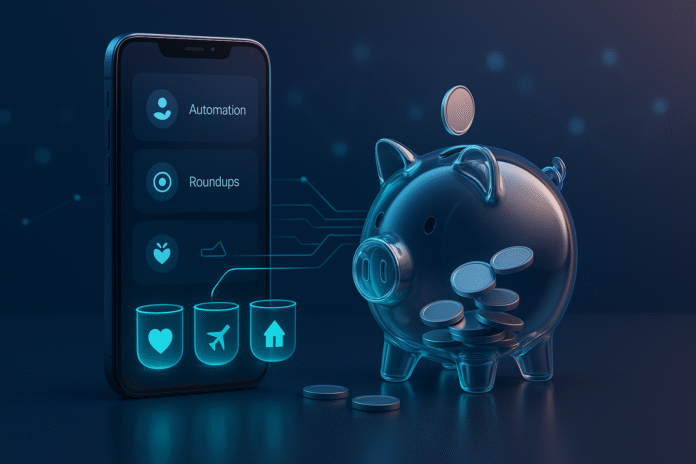If you’ve felt like simple savings accounts haven’t kept up with the way you move money, you’re not wrong. The future of saving is already here—delivered through high-interest accounts that pair competitive yields with clever automation, smarter protections, and delightful UX. In today’s market, leading high-yield accounts commonly post variable rates around the mid–4% range, and many layer on tools such as savings buckets, roundups, direct-deposit routing, and even prize drawings. This guide explores the innovative features in the top five high-interest accounts shaping how we save now—and how you can put them to work, step by step.
Disclaimer: This article is for education only and not financial advice. Savings rates change frequently, and your ideal setup depends on your goals, tax situation, and risk tolerance. Consider consulting a qualified professional for personal guidance. FDIC and SIPC protections have limits and conditions; always verify details with the provider.
Key takeaways
- High-interest accounts are evolving beyond static APYs to include automation, savings buckets, cash routing, and even prize-linked incentives.
- Competitive yields today often cluster around the mid–4% range, while promos and boosts can push your rate higher for limited periods.
- Safety differs by account type. Bank accounts rely on FDIC insurance (generally $250K per depositor, per bank, per ownership category); brokerage and cash-management accounts may use FDIC sweep programs or rely on SIPC for brokerage failures.
- Automation is a force multiplier. Features like buckets, roundups, and paycheck routing can raise your real (not just nominal) savings rate by making consistency effortless.
- You still need to monitor. Sweep programs and default cash settings at brokerages don’t always pay the best rates, so learn the knobs and check your APY regularly.
1) Wealthfront Cash Account — Autopilot cash routing, outsized FDIC coverage, and modern cash UX
What it is & core benefits
Wealthfront’s Cash Account is a brokerage cash product that pays a competitive variable APY, lets you move money instantly to and from linked accounts, and automates where your cash goes with Autopilot (part of its “self-driving money” vision). The account uses a network of program banks to extend FDIC insurance up to $8 million ($16 million for joint accounts), well beyond the single-bank baseline.
Standout innovations
- Autopilot / self-driving money: Set a “cash floor” for your checking; excess automatically routes to savings or investment accounts—no manual transfers required.
- High total FDIC coverage via program banks (with transparent bank lists and allocation).
- Instant withdrawals and $0 account fees for frictionless cash access.
Requirements & low-cost alternatives
- Requirements: U.S. resident with a compatible bank account for linking; no minimum to earn advertised APY.
- Low-cost alternative: If you prefer a bank account (not brokerage), some online HYSAs offer similar yields; however, you’ll typically get standard FDIC limits per bank rather than a pooled network.
Step-by-step: Getting started
- Open a Cash Account and link your external checking. Set up direct deposit if you want it to route in.
- Turn on Autopilot: choose a checking “cash floor” and destinations (Cash Account or investment).
- Create goal-based buckets (emergency, travel, taxes). Schedule recurring transfers to each.
Beginner modifications & progressions
- Simplify: Start with one automation rule—keep, say, $1,000 in checking and sweep the rest weekly.
- Progress: Add category-specific buckets (e.g., insurance, home maintenance) and increase the cash floor as income grows.
Recommended cadence & metrics
- Cadence: Review rules monthly; tweak your cash floor after raises or big expenses.
- Metrics: Track average daily balance, monthly interest earned, and transfer success rate (how often Autopilot ran).
Safety, caveats & mistakes to avoid
- Know what protects you: FDIC applies once cash lands at program banks; before settlement, coverage differs. Confirm allocations and avoid exceeding $250K per bank if you hold other deposits there.
- Rates are variable. If rates fall, consider whether you need to shift cash to short-term alternatives.
Sample mini-plan
- Set a $2,000 cash floor for checking.
- Autopilot: sweep all excess to your “Emergency” bucket weekly; target three months’ expenses first.
2) Betterment Cash Reserve — Big-bank network coverage with temporary APY boosts
What it is & core benefits
Cash Reserve is a high-yield cash account that prioritizes simple setup, broad FDIC insurance through program banks (up to $2 million for individuals, $4 million for joint accounts), and a tidy interface that fits neatly alongside Betterment’s investing tools. The base APY is variable, and promotions occasionally offer limited-time APY boosts.
Standout innovations
- Promotional APY boosts (for new and tenured clients) that temporarily add to your base APY—useful in a rate-cutting environment.
- High FDIC coverage via program banks without account fees or minimums.
Requirements & low-cost alternatives
- Requirements: Open a Cash Reserve account; link a bank. No minimums to earn the posted APY.
- Alternative: Traditional HYSAs if you prefer a pure bank relationship; yields are comparable, but features and coverage differ.
Step-by-step: Getting started
- Open Cash Reserve and connect your bank.
- If eligible, activate any APY boost promotion and set a reminder for the boost end date.
- Add automatic transfers to align with your pay cadence.
Beginner modifications & progressions
- Simplify: One recurring transfer per payday.
- Progress: Layer in goal targets (e.g., emergency = 3–6 months) and schedule a quarterly APY review to shop rates.
Recommended cadence & metrics
- Cadence: Monthly review; re-price after any Fed move or provider email.
- Metrics: Net APY including boosts, total monthly interest, and time-to-goal.
Safety, caveats & mistakes to avoid
- Promos end. Don’t assume an elevated APY is permanent; confirm the date and the post-promo rate.
- FDIC mechanics: Coverage comes from program banks; watch your totals per bank if you hold deposits elsewhere.
Sample mini-plan
- Move your emergency fund to Cash Reserve.
- Trigger the boost by making the qualifying deposit, and set a calendar note to reassess 30 days before the boost expires.
3) SoFi Checking & Savings — Buckets (“Vaults”), Roundups, and early-pay tools that make saving automatic
What it is & core benefits
SoFi’s combined checking and savings setup is designed to nudge you into consistent saving without extra apps. Savings Vaults act like labeled buckets, Roundups sweep spare change from purchases into your Vaults, and direct deposit can arrive up to two days early. APY tiers depend on meeting deposit criteria.
Standout innovations
- Vaults and Roundups for frictionless goal-based saving inside your main bank app.
- Early paycheck availability (varies) to improve cash-flow timing.
- Overdraft coverage up to a small amount when criteria are met, with separate overdraft protection from savings.
Requirements & low-cost alternatives
- Requirements: Open linked checking and savings; optional direct deposit or qualifying deposits to unlock the higher savings APY tier.
- Alternative: If you prefer not to switch your main bank, you can replicate roundups using a separate savings app or your card issuer’s roundup feature where available.
Step-by-step: Getting started
- Open SoFi Checking & Savings; set up direct deposit or qualifying deposits to target the higher APY tier.
- Create Vaults (e.g., emergency, travel).
- Turn on Roundups and assign them to a Vault.
Beginner modifications & progressions
- Simplify: Start with one Vault and Roundups only.
- Progress: Add auto-transfers per payday, then split your paycheck by percentage across multiple Vaults.
Recommended cadence & metrics
- Cadence: Weekly glance to confirm deposits hit; monthly review of Vault progress.
- Metrics: Roundup totals per month, percent of paycheck saved, and estimated months to goal.
Safety, caveats & mistakes to avoid
- APY criteria: Your APY can drop if you don’t maintain the qualifying deposits or direct-deposit status; check the APY details page.
- Early paycheck variability: Availability depends on when the employer sends payroll files; it’s not guaranteed to be exactly two days early every cycle.
Sample mini-plan
- Turn on Roundups to your “Emergency” Vault.
- Add a 10% paycheck auto-transfer into “Emergency” and 5% into “Travel.” Check the APY details monthly.
4) Fidelity Cash Management Account — Bank-like spending, ATM fee rebates, and FDIC sweep options
What it is & core benefits
Fidelity’s Cash Management Account (CMA) is a brokerage account that behaves like a checking account—free debit card, bill pay, and ATM fee reimbursements—while sweeping uninvested cash to FDIC-insured program banks (subject to limits). It’s a convenience powerhouse if you also invest at Fidelity.
Standout innovations
- FDIC-insured sweep to program banks, with automatic handling of over-the-limit balances via money market overflow.
- ATM fee reimbursement at virtually any ATM in the network, credited automatically the same day.
Requirements & low-cost alternatives
- Requirements: Open a Fidelity brokerage CMA; link your bank if desired.
- Alternative: A pure HYSA may pay more if you don’t need brokerage features. Recent coverage shows many brokerages pay below top HYSA yields on default sweeps—know your options.
Step-by-step: Getting started
- Open a CMA and choose the FDIC sweep option; review the program bank list.
- Enable bill pay and link your card; set alerts for low balance.
- If you keep larger balances, consider a money market fund for higher yield and manually move funds when needed.
Beginner modifications & progressions
- Simplify: Use CMA purely for bill pay and everyday spending.
- Progress: Park strategic cash in a government money market fund (not FDIC-insured) for yield, while keeping a small sweep balance for payments.
Recommended cadence & metrics
- Cadence: Weekly check on cash levels; monthly compare your sweep rate vs. a money market fund.
- Metrics: Average sweep APY, ATM fees reimbursed, and net interest earned.
Safety, caveats & mistakes to avoid
- Protection types differ: Balances swept to banks get FDIC coverage (limits apply); money market funds are investments (not FDIC-insured) but the brokerage relationship is covered by SIPC in case of firm failure (limits apply).
- Default sweep yields can lag top HYSAs; don’t assume your broker pays the best rate by default.
Sample mini-plan
- Keep one month of bills in the FDIC sweep; move any excess into a government money market fund on the first business day of each month. Refill from sweep as needed.
5) Prize-Linked Savings (PrizePool) — Behavioral motivation with cash-prize drawings
What it is & core benefits
Prize-linked savings accounts pair a standard savings base with gamified drawings that award cash prizes when you deposit and keep money saved. The idea: leverage lottery-like excitement to encourage a healthy habit. PrizePool, a popular U.S. option, partners with a bank for FDIC-insured deposits and offers weekly drawings with thousands of prizes.
Standout innovations
- Tickets for deposits and activity that increase your odds of winning, on top of your base APY.
- FDIC-insured banking partner for deposit coverage up to standard limits.
Requirements & low-cost alternatives
- Requirements: Open a PrizePool account and connect your bank; deposits must sit to qualify for drawings.
- Alternative: If you dislike variable, prize-based upside, a plain HYSA with steady APY may fit better.
Step-by-step: Getting started
- Open the account and set a fixed monthly transfer (e.g., on payday).
- Review prize rules—how tickets are earned and how long deposits must remain to qualify.
- Set a personal “minimum balance” rule so you don’t sabotage your odds with frequent withdrawals.
Beginner modifications & progressions
- Simplify: Treat prize-linked savings as a fun side bucket (e.g., holiday fund).
- Progress: Ladder several goal buckets across a prize-linked account plus a HYSA to blend steady yield with potential wins.
Recommended cadence & metrics
- Cadence: Weekly check for prize notifications; quarterly review your effective annualized return (base yield plus prizes).
- Metrics: Average balance, tickets per month, number and value of prizes.
Safety, caveats & mistakes to avoid
- Uncertain outcomes: Prizes are variable; don’t base essential goals (e.g., emergency fund) solely on prize-linked returns.
- Coverage specifics: Confirm your funds sit in an FDIC-insured account at the partner bank and understand standard coverage limits.
Sample mini-plan
- Auto-transfer $100 per payday to PrizePool; leave it untouched for a full quarter to maximize drawing eligibility. Reassess after 90 days.
Quick-start checklist
- Open one primary high-interest account from the list above that matches your style (automation, bank-centric, or brokerage-centric).
- Turn on automation (Autopilot, Vaults, Roundups) for at least one goal.
- Verify protection type and limits (FDIC or SIPC). Add program banks to your spreadsheet to watch per-bank totals.
- Schedule a monthly APY check and a quarterly “shop the rate” ritual.
- Set a cash floor for checking; sweep the rest to savings automatically.
Troubleshooting & common pitfalls
“My APY dropped unexpectedly.”
Check whether a qualifying deposit requirement expired (common with bank HYSAs) or a promo ended (common with cash accounts). Review your provider’s APY details page.
“I’m not getting paid early.”
Early direct deposit depends on employer payroll timing; some cycles may not arrive two days early. It’s not guaranteed every time.
“My broker’s default sweep pays very little.”
Many brokerages route uninvested cash to low-yield sweep programs by default. Consider a money market fund or a separate HYSA for higher yield.
“Do I really need multiple accounts?”
You don’t have to, but mixing a high-automation account (for behavior) with a high-coverage cash account (for safety) and, optionally, prize-linked savings (for motivation) can raise your effective results.
“Is a money market fund the same as a money market account?”
No. A money market fund is an investment (not FDIC-insured) that may be held in a brokerage; a money market deposit account is a bank deposit with FDIC insurance up to limits.
How to measure your progress (and make it tangible)
- Monthly interest earned vs. prior month (trend).
- Savings rate: percentage of take-home pay routed to savings/goal buckets.
- Time-to-goal: months until each bucket reaches its target.
- Coverage map: per-bank deposits vs. $250K FDIC limit; brokerage cash vs. SIPC.
- Effective return (if prize-linked): base APY plus prize value annualized.
A simple 4-week starter plan
Week 1 — Choose & connect
- Pick your primary account: automation-first (Wealthfront or SoFi), promo-friendly (Betterment), or brokerage-centric (Fidelity CMA).
- Open and link your checking. Turn on any APY boost if you’re eligible.
Week 2 — Automate deposits
- Establish a cash floor in checking (e.g., one week’s expenses).
- Add an automatic payday transfer into your emergency bucket; enable Roundups if using SoFi.
Week 3 — Map protections & rates
- Document your per-bank exposure vs. FDIC limits; if you’re in a program-bank setup, list the banks and your current allocations.
- If using a brokerage, compare sweep yield vs. a money market fund and decide if manual moves are worth it.
Week 4 — Optimize & expand
- Add a secondary bucket (e.g., travel) or try a prize-linked side bucket to boost motivation.
- Schedule monthly APY reviews and quarterly rate-shopping.
FAQs
1) Are these rates guaranteed?
No. All APYs discussed here are variable and can change at any time. Providers and aggregators show the latest posted rates—check before moving funds.
2) What’s the difference between FDIC and SIPC?
FDIC covers deposits at insured banks up to set limits per depositor, per bank, per ownership category. SIPC protects brokerage assets if the firm fails (up to $500,000 total, including $250,000 for cash) but does not protect against market loss.
3) Is a brokerage cash account as safe as a bank savings account?
It depends. Many brokerage cash accounts use FDIC sweep programs to provide deposit insurance at partner banks; otherwise, SIPC applies at the brokerage level. Read the disclosures to understand when FDIC applies.
4) How early is “early direct deposit”?
It can be up to two days early when payroll files arrive sooner—but it’s not guaranteed every cycle.
5) Do prize-linked savings accounts really pay more?
They can increase your expected return through prizes, but outcomes vary. Treat prizes as a bonus, not a plan. Verify that deposits sit in an FDIC-insured bank account.
6) Can I exceed $250,000 of FDIC insurance at one bank?
Coverage is per ownership category, so titling matters. Many cash accounts spread deposits across multiple banks to extend total coverage—but you still need to track totals per bank.
7) Why does my brokerage sweep yield less than money market funds?
Default sweeps often pay below market; some firms have cut sweep rates even as money market funds remained higher. You may need to manually move cash for better yield.
8) What if my APY relies on direct deposits—should I risk it?
If you can maintain the requirement, the higher rate can be worth it. But set alerts so you catch any status change quickly; otherwise your APY can drop to a base tier.
9) Are money market funds safe for an emergency fund?
They aim to preserve capital and are generally conservative, but they’re still investments (not FDIC-insured). Evaluate liquidity needs and your risk tolerance.
10) How often should I shop around for a better APY?
Monthly checks are reasonable; quarterly, do a deeper review. In a shifting rate environment, the leader board moves.
11) Can I combine multiple accounts?
Yes—many savers mix an automation-heavy account (for behavior), a program-bank cash account (for coverage), and a prize-linked bucket (for motivation). Just keep your tracking simple.
12) Are there withdrawal limits I should know about?
Savings accounts no longer have the old federal six-transfer cap, but institutions may impose their own policies. Always check your provider’s terms before scheduling frequent sweeps.
Conclusion
The best high-interest accounts no longer win only on rate. They win on behavioral design—automations that help you save without thinking, safety frameworks that extend coverage, and incentives that keep you engaged. Choose the account that matches how you live, automate one small habit this week, and let the future of saving quietly compound in the background.
CTA: Open one high-interest account today, turn on a single automation, and set a 30-day reminder to check your progress.
References
- Best High-Yield Savings Accounts of August 2025: Up to 4.46%, NerdWallet, updated August 2025, NerdWallet
- 11 Best Savings Accounts of August 2025: Up to 4.46%, NerdWallet, updated August 2025, NerdWallet
- Best High-Yield Savings Accounts – August 2025, Kiplinger, August 2025, Kiplinger
- Best high-yield savings account rates (August 8, 2025), Fortune, August 2025, Fortune
- Deposit Insurance FAQs, FDIC, updated April 2024, FDIC
- Deposit Insurance at a Glance, FDIC, updated April 2024, FDIC
- What SIPC Protects, Securities Investor Protection Corporation, accessed August 2025, sipc.org
- Wealthfront Cash Account — Earn 4.00% APY (variable), Wealthfront, accessed August 2025, Wealthfront
- FDIC Insurance for Cash Accounts, Wealthfront Help, updated April 2024, Wealthfront Support
- Program Banks, Wealthfront, accessed August 2025, Wealthfront
- Meet Autopilot: Automate Your Savings Strategy, Wealthfront Blog, September 2, 2020, Wealthfront
- Wealthfront Delivers on Self-Driving Money, PR Newswire, April 20, 2021, PR Newswire
- Betterment Cash Reserve — Earn 4.00% APY (variable), Betterment, accessed August 2025, Betterment
- New Client 0.65% APY Boost Offer Terms, Betterment, updated August 7, 2025, Betterment
- Tenured Client 0.65% APY Boost Offer Terms, Betterment, updated August 7, 2025, Betterment
- SoFi Banking — Checking & Savings APY Details, SoFi, accessed August 2025, SoFi
- SoFi Vaults (Savings Buckets), SoFi, accessed August 2025, SoFi
- SoFi Roundups, SoFi, accessed August 2025, SoFi
- How Early Paycheck Works, SoFi Support, November 10, 2022, SoFi
- Overdraft Coverage & Protection, SoFi, accessed August 2025, and SoFiSoFi
- Fidelity Cash Management Account Overview, Fidelity, accessed August 2025, Fidelity
- Features by Account (ATM Fee Reimbursements), Fidelity, accessed August 2025, Fidelity
- FDIC-Insured Deposit Sweep Program Bank List, Fidelity, accessed August 2025, Fidelity
- Brokerage Firms Are Cutting Payouts on Uninvested Cash, Barron’s, December 2024, Barron's
- Vanguard Federal Money Market Fund (VMFXX) — 7-Day SEC Yield as of August 12, 2025, Vanguard, accessed August 2025, Vanguard
- Mutual Funds Are Not FDIC-Insured, Investopedia, accessed August 2025, Investopedia
- What Are Prize-Linked Savings Accounts?, SmartAsset, June 13, 2025, SmartAsset
- PrizePool — Prize-Linked Savings (FDIC note and prize details), PrizePool, accessed August 2025, and https://getprizepool.com/blog/category/prize-linked-savings/ getprizepool.com
- How a HYSA with Savings Buckets Works, Yahoo Finance, June 18, 2025, Yahoo Finance






